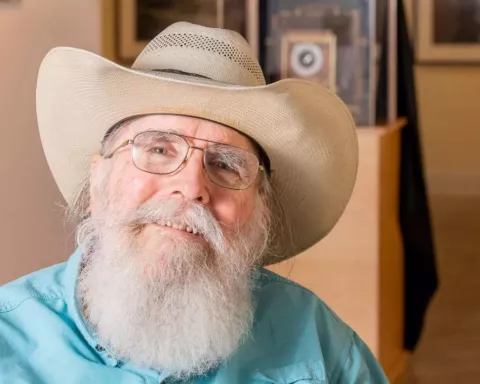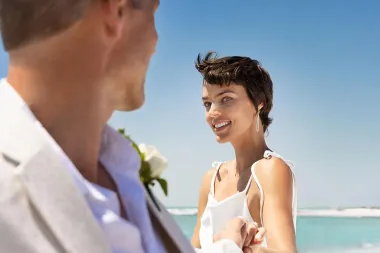The Everglades: Through the Lens of World-Famous Photographer Clyde Butcher

The Everglades is a genuinely wild, unspoiled area, a marked contrast to the luxurious surroundings of Naples and the upscale resorts of Marco Island. And while more and more visitors to Florida’s Paradise Coast are taking day trips to the Everglades for a change of pace, the area is still lightly traveled.
World-famous nature photographer Clyde Butcher, who has a gallery in the Everglades, offers a theory as to why. “Well, one of the reasons I think it’s unspoiled is because people think it’s a swamp,” he says. “And people are scared to go into it, thinking it’s muddy, with snakes and alligators and all that stuff. So the illusion of it not being safe is helping protect it.”
Illusion. That’s the key word. The Everglades is not a swamp as is commonly understood. It’s not boggy or even bleak, as some might think. It’s a vast grassland flooded with clear, fresh water. The bottom consists of soft peat, silt and sand. The Big Cypress National Preserve — the western half of the Everglades that’s part of Florida’s Paradise Coast — bursts with plant life. The animals keep to themselves. “Gators really want nothing to do with humans,” says a nature guide named Trish. “We don’t provide food for them. We’re tall. We’re pretty smelly beasts to them. The same goes for snakes.”
In Big Cypress, you’ll see majestic birds take off from trees and soar overhead. You’ll encounter thickets where the air temperature suddenly drops, during the hot months especially. “In August, the Everglades is the coolest spot in Florida — maybe by five, even 10 degrees,” Butcher asserts.
He should know. The photographer lived for 15 years in a stilt home in a watery strand behind the gallery, which is located an hour’s drive southeast of downtown Naples.
The 82-year-old Butcher has taken wilderness photos all over the country but is best known for his large-scale, black-and-white pictures of the Everglades. They are captivating works of art, full of depth and detail. “I started out as an architect,” he says. “And what we do with architecture is bring people into buildings. I want something similar in my photographs — to draw people’s eyes in, so it’s like being there.”
Butcher’s photographs don’t come easily. One of his most famous, Cigar Pond Orchid — the photo he feels best captures the essence of the Everglades — took nine years to achieve. He happened upon the magical spot in January 2000, during one of his regular walks through Big Cypress. The tableau seized his attention, but the conditions were all wrong.

“There are several considerations,” he explains, referring to when and how he takes a photo. “Is the light right? Is the water right? Are the plants right? Is the wind blowing? I take the camera out there, and if it’s not right, I don’t shoot.”
To get the depth and detail found in Cigar Pond Orchid required an exposure of “three or four minutes,” so conditions had to be perfect. After 10 return trips, each requiring a 90-minute walk to get there, everything came together in 2009. Butcher set up his large-format tripod camera and got his shot. “It takes some patience,” he says with considerable understatement.
At the Clyde Butcher Big Cypress Gallery, you can immerse yourself in the many large images on the walls. (The biggest are 5-feet by 9-feet.) You’ll view the artworks in high-and-dry, air-conditioned comfort. But there’s another activity at the gallery: the Guided Swamp Walk Eco-Tour. It’s one of many natural attractions you can experience in the Everglades. (If calling it a “swamp walk” seems counterintuitive, Butcher explained that when they started them 30 years ago, they wanted to give it a name that would tantalize tourists into giving it a try.)
One of the eco-tour’s aims is to help people understand the mystical allure of the Everglades, while at the same time erasing the innate fear people have.
Here’s how it works: Swamp-walkers are encouraged to wear long pants and an old pair of sneakers (not boots, which slow you down). Depending on the season, guests might suit up in gear that protects against mosquitos. Water depth generally ranges from ankle high to four feet, and changes throughout the walk. A guide leads you through an unmarked trail in a slow trek that lasts about 90 minutes.

“One thing we encourage is to not say anything for the first five to 10 minutes,” Butcher says. That way, you can fully appreciate the remarkable sights and subtle sounds — wind rustling the branches, the swishing of water, the flapping of birds’ wings, the croaking of frogs, the rat-tat-tat of woodpeckers. You’ll hear no traffic or heavy machinery or random hums. Just nature. “That’s difficult to find in America,” Butcher says. The guide’s job, he adds, “is to educate you and allow in the feeling of what the place is all about, and how precious it is.”
First-time visitors to the Everglades should not attempt their own jaunt through a wetlands area. There are virtually no marked trails, so losing your way is not out of the question. It is best to go on a guided tour like the one offered at Big Cypress Gallery. But whenever you venture out into the Everglades, Butcher cautions that “you should always go in with at least one other person.”
There’s another very significant reason that Big Cypress Preserve is unspoiled. In 1974, President Gerald Ford established the 729,000-acre tract as the first national preserve in the United States. Butcher, who has long played a role in Everglades conservation, says, “The reason Big Cypress is protected is because the hunters, the farmers, the fishermen, the conservationists — everybody got together to save it,” Butcher says.
And let us add to that group a certain photographer, whose images have exposed the enchantment and magnificence of the Everglades to people around the world, and whose nature walks have allowed visitors to truly feel the place, up close and personal.
We encourage visitors staying in Naples or Marco Island to set aside a few hours to visit the Everglades. After an invigorating jaunt into uncharted territory, you’ll return to the fine-dining and waterfront restaurants, easy-breezy beach bars, and the arts and culture you’ve grown accustomed to in the civilized areas of Florida’s Paradise Coast. It’ll all still be there, we promise.
Explore More of Paradise Coast

From “Yes” to “I Do”: A Guide for Planning Your High-End Wedding in Naples & Marco Island

Luxury Micro-Weddings: How to Host an Exclusive & Intimate Wedding in Naples

Plan an Elevated Escape to LaPlaya Beach & Golf Resort

Three Days of Quiet Luxury at The Escalante in Naples

The Ultimate Adult-Exclusive Experience at JW Marriott Marco Island Beach Resort
